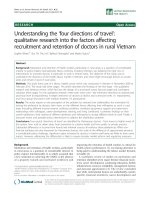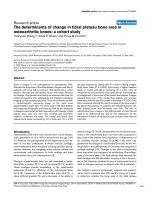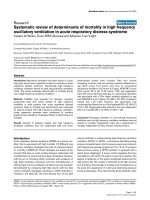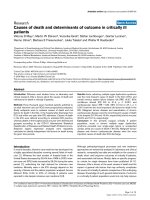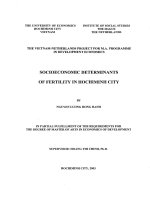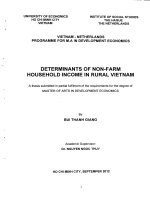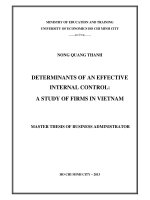DETERMINANTS OF POVERTY REDUCTION POTENTIAL OF LAND IN RURAL VIETNAM
Bạn đang xem bản rút gọn của tài liệu. Xem và tải ngay bản đầy đủ của tài liệu tại đây (332.94 KB, 46 trang )
Website: Email : Tel : 0918.775.368
NATIONAL ECONOMICS UNIVERSITY INSTITUTE OF SOCIAL STUDIES
HA NOI THE HAGUE
DETERMINANTS OF POVERTY REDUCTION
POTENTIAL OF LAND IN RURAL VIETNAM
A THESIS PRESENTED BY
HA CHI HAI
In Partial Fulfillment of the Requirements for Obtaining the Degree of
MASTER OF ARTS IN ECONOMICS OF DEVELOPMENT
SUPERVISOR
Assoc.Prof. Dr. NGUYEN QUANG DONG
HANOI - 2007
ACKNOWLEDGEMENT
In completing my thesis, I have been received considerable and kind support from
many people, to whom I would like to give my special thanks.
First of all, I would like to express my special thanks to Assoc. Prof. Dr. Nguyen
Quang Dong, for his valuable time reading my drafts and giving me helpful guidance,
support and suggestions.
I am grateful to Prof. Dr. Sc. Vu Thieu for his lectures on research methodology and
econometric. I also would like to thank all the teachers and the staff in the Vietnam –
Netherlands Master Project who have given my classmates and me their enthusiasm,
kindness and effective help during our course.
Finally, I am deeply indebted to my family, MDE classmates for their spiritual
encouragement throughout the preparation and development of this thesis. Without their
heartfelt love and support, the thesis would have been made impossible.
HA CHI HAI
November 2007
i
ABSTRACT
This thesis examines the role of land as an instrument of poverty reduction, combine
with conditions under which access to land in Vietnam rural. The thesis employs parametric
methods and data from Vietnam Living Standard Survey 2002. The results show that
marginal welfare value of land is quite high. An increase of 1 hectare will increase annually
income by 2,700,000 VND a year, but there is a wide range of difference in return to land
among regions. Education is an important factor contributes to household welfare, a marginal
increase in the household head’s education level raises welfare by 2,498 thousand VND/year
if the head finished primary level and reach up to 14,929 thousands if the heads have
education attainment from vocational program, colleague and university or higher.
In addition, the marginal welfare value of land depend importantly other conditions
under which land is used by households such as household and local characteristics
ii
TABLE OF CONTENTS
ACKNOWLEDGEMENT i
ABSTACT ii
LIST OF TABLES iii
LIST OF ABBRIVIATIONS v
CHAPTER I 1
INTRODUCTION 1
1.1 Research topic 1
1.2 Research objectives, scope and focus of the study 2
1.3 Research questions 2
1.4 Methodology 2
1.5 Data 3
1.6 Structure of the thesis 3
CHAPTER II
METHODOLOGICAL FRAMEWORK 4
I. Theoretical framework 4
II. Econometric specification of the welfare equation 6
III. Literature review 7
CHAPTER III
OVERVIEW OF LAND ALLOCATION IN VIETNAM’ AGRARIAN
TRANSITION AND POVERTY
10
I. OVERVIEW OF LAND ALLOCATION IN VIETNAM’ AGRARIAN
TRANSITION
10
1.1 Land reform in Vietnam 10
1.2 The process of land allocation 14
1.3 Land use in Vietnam 15
II. POVERTY IN VIETNAM 17
2.1. Overall Poverty in Vietnam 17
2.2 Dimensions of poverty in Vietnam 17
2.3 Summary of characteristics of poverty in Vietnam 20
CHAPTER IV
iii
ESTIMATION RESULTS OF HOUSEHOLD WELFARE 22
I. DATA 22
II. DESCRIPTION OF VARIABLES 23
1. Dependent variable 23
2. Explanatory variables 23
III.ESTIMATION RESULTS: The household welfare generating potential of
land
25
SUMMARY OF FINDINGS
29
CHAPTER V
CONCLUSION AND POLICY IMPLICATIONS 30
I. CONCLUSION 30
II. POLICY IMPLICATIONS 30
III. SUGGESTION FOR FURTHER STUDY 31
REFERENCES 32
APPENDICES 35
iv
LIST OF TABLES
Table 1 - Major annual crops grown in Vietnam, 1995-2000 16
Table 2: Indicators of poverty in Vietnam 1990-2002 17
Table 3: Spatial dimensions of poverty and inequality in Vietnam 18
Table 4: Ethnic and gender dimensions of poverty in Vietnam 19
Table 5: Socio-characteristics of Vietnam’s poverty profile 20
Table 6: Number of household by region 22
Table 7 - Estimation of the welfare household index 27
v
LIST OF ABBREVIATIONS
CH Central Highland
CPI Consumers’ Price Index
GSO General Statistics Office of Vietnam
MKD Mekong Delta
NCC North Central Coast
NE North East
NW North West
OLS Ordinary Least Square
RRD Red River Delta
SCC South Central Coast
SE State-Owned Enterprises
VLSS 2002 Vietnam Living Standards Survey in 2002
VND Vietnamese Dong
WB World Bank
vi
CHAPTER I
INTRODUCTION
1.1 Research topic
The role of land in economic theory is extensively documented. Originally, land used by
agriculture was the main motivation for an economic treatment of land. Prominent effort of classical
economist was to established relation between land, labor and capital and its contribution to economic
growth. Later, land use did not occupy an important position in neoclassical core economic theory,
they considered it as a production factor of relatively little importance. Land as the principal source of
wealth in classical economics lost its central role in neoclassical economics (Klaus; Jeroen, 2002).
In reality, land in agricultural production still plays a key role both in term of household wealth
and mean of poverty reduction. Access to land has for many years advocated as one of the potentially
most effective approaches to rural poverty alleviation (Warriner, 1969; Thiesenheusen, 1989;
Bingswanger et al., 1995). Therefore land reforms in developing countries aimed to give the poor
opportunity to help them go out of poverty status. It was not far away from favoring low income
people, pro-poor policy in Vietnam has extensively and dramatically performed land reform over
renovation process (Doi Moi) since 1986. Vietnam started to transform its rural sector from
collectivized agricultural production to a system based on households’ initiative, a move that
culminated in the passage of the 1988 Land Law. A new law was enacted in July 1993 to deal with
factors such as threats of administrative reallocation, short duration of use rights, lack of
transferability and the inability to use land as collateral. Studies have shown that this led to significant
increases in overall rural productivity, although pre-existing differences between North and South
were not eliminated (Pingali and Xuan 1992, Tran 1998), other study suggest that land allocation
responded positively but slowly to the inefficiencies of the administrative allocation (Ravallion, M;
Walle, D.V.D). We see that there is, however, a remarkable absence of solid empirical evidence
measuring the potential of land in reducing poverty in Vietnam, particularly carefully taking into
account the specific conditions under which land is used by beneficiaries, when we well know that
these conditions are key determinants of success or failure. Aim to analyze further these effective
factors basically and systemically, the topic “Determinants of poverty reduction potential of land in
Vietnam rural” will be employed for my thesis.
1
1.2 Research objectives, scope and focus of the study
This thesis will examine determinants of poverty reduction potential of land in Vietnam rural
from Vietnam Living Standards Survey in 2002 (VLSS 2002). In the thesis, I will focus on exploring
the relationship between income and agricultural land endowment of household where household
mainly generate income from agricultural land and taking into account the specific conditions under
which land is used by beneficiaries.
The study focuses on four main works. Firstly, it is to introduce a general framework.
Secondly, it is to provide a overview of agricultural land and poverty in Vietnam. Thirdly, it is to
estimate household welfare equation, which include without and with correcting selectivity bias,.
Finally, the study provides policy implications to agricultural land.
1.3 Research questions
The thesis is to address main question:
Which determinants cause heterogeneity in marginal returns to land for households endowed with
agricultural land in Vietnam?
Sub-questions include:
Does marginal return to land endowed by household increase by area of agricututal land?
Are there any differences in welfare of household by regions?
Are there any differences in welfare of household by household characteristics, by which
ways?
Are there any differences in welfare of household by education?
1.4 Methodology
The study reviews theoretical frameworks and relevant researches of the research topic. The
research questions will be addressed by the quantitative method. Based on theoretical framework,
household welfare equation is estimated, including selectivity correction. In addition, statistical and
descriptive analyses are used as well.
2
1.5 Data
This study is based on the data from the Vietnam Living Standards Survey 2002 (VLSS 2002)
which conducted by World Bank (WB) and the General Statistic Office (GSO) of Vietnam. The
survey provides detailed information about employment, income, education, and demographic
characteristics of household members.
1.6 Structure of the thesis
The thesis is divided into five chapters:
Chapter 1: Introduction
Chapter 2: Introduces theoretical considerations, methodological framework, and a brief of relevant
literatures on returns to agricultural land.
Chapter 3: Provides an overview agricultural land and poverty in Vietnam..
Chapter 4: Presents estimation results of household welfare equations.
Chapter 5: Summarizes main findings and provides policy implications based on the results
3
CHAPTER II
METHODOLOGICAL FRAMEWORK
This chapter introduces a economic framework for welfare equation. This chapter has three
sections. Section one gives a review of economic theory for welfare equation. Section two introduces
welfare equation. Section three is literature review.
I. Theoretical framework:
In this section we derive the specification of our income equation from a agrarian household
production model. We consider a situation of multiple market imperfections to investigate how these
distortions affect the economic return to land. The theoretical framework borrows from the work of
Carter and Mesbah (1993) and it assumes three important frictions: 1) Land transactions are ignored
and access to land is treated as exogenous, 2) households face the possibility of off-farm
unemployment, and 3) access to credit increases with land size.
Under these assumptions, consider a household that generates income by cultivating agricultural
land, in addition to possibly supplying labor at an exogenously determined market wage, w. The
household is endowed with T hectares of land and
L
hours of labor per year that are employed in on-
farm agricultural work (L
f
) and/or off-farm activities (Ls). The household cultivates a single crop
using X units of input purchased at a per unit market price of q. The crop can be sold at an exogenous
market price p. Let F(L
f
,X,T;z) be the production function, where z represents the set of household and
contextual characteristics that affect the return on productive assets. Let Ω(Ls) denotes the number of
days employed as a function of labor supplied, Ls, where Ω’>0, Ω”
0
≤
. Let Ґ(T) denotes the amount
of working capital available at an interest rate i to a household with land endowment, T. The cost of
production, qX, must be financed by the sum of initial wealth K, wage income wΩ(Ls), and available
capital Ґ (T).
Formally, the household chooses time allocation and purchased inputs to maximize its income:
max pF(L
f,
X, T;z) – qX + wΩ(Ls) – i(qX - K - wΩ(Ls))
Subject to
4
L
f
+ L
s
L
≤
qX
+≤
K
wΩ(Ls) + Ґ(T)
L
s
, L
f
0
≥
(1)
Assuming an interior solution for the labor allocation, the first-order conditions of this maximization
problem can be written:
pF
L
= w(1 + I + λ)Ω’
pF
x
= q(1 + i + λ)
λ(K + w Ω(Ls) + Ґ(T) – qX = 0; λ
≥
0; K + wΩ(Ls) + Ґ(T) – qX
≥
0 (2)
So that we have maximum in Y with optimal value of L
f
*
,
L
s
*
, X
*
Y = pF(L
f
*
,
X
*
, T;z) – q(1 + i)X
*
+ w(1 + i)Ω(Ls
*
) + iK
= Λ(p,q,i,w,
L
, K,T,z) (3)
The income equation is a function of prices, household’s endowment of productive assets, and
any characteristic that affects the return to these assets. We can differentiate Eq. (3) to see how an
increase in landholdings affects household income,
dT
dY
= pF
T
+ (pF
L
– w(1 + i) Ω’)
dT
dLf *
+ (pF
x
– q(1 + i))
dT
dX *
= pF
T
+ λw Ω’
dT
dLf *
+ λq
dT
dX *
(4)
If capital markets are perfect (λ =0), then the terms in parentheses are identically equal to zero
and the marginal value of land is simply the value of its marginal product, i.e., dY/dT = pFT.
Moreover, if households face the same opportunity costs of labor and inputs, and we assume constant
returns to scale, then the marginal return to land is constant for all land endowments.
Conversely, with imperfections in labor and credit markets, the terms in parentheses are positive.
An increase in landholding has both a direct and an indirect effect on income. In addition to
directly increasing production, more land affects the distortions in the allocation of production inputs.
As the land endowment increases, labor allocated to the farm increases, the under-employment
rate Ω decreases, and the marginal productivity of labor Ω’ increases. On the other hand, as the land
5
endowment increases, the credit constraint may either tighten or loosen (k can increase or decrease)
depending on the relative increase in credit availability Γ(T) and on the demand for inputs. For
instance, in poor rural areas characterized by thin labor markets, an increase in household land will
increase the marginal product value of household labor and reduce the difference between its
shadow wage and the market wage. If, as Eswaran and Kotwal (1986) suggest, larger farms have
better access to credit, then an increase in landholding will increase the use of variable inputs and
reduce the distortion in the input markets as well. With market distortions, we consequently expect the
marginal value of land to vary with the land endowment, and quite possibly in a nonlinear
manner.
II. Econometric specification of the welfare equation
This section outlines the semi-parametric procedure for estimating the relationship between
income and land endowments. Our production model implies that any characteristic that affects the
return to the productive assets of the household should influence the household’s income. This list
includes household demographics, constraints on factor use, as well as village and regional factors that
capture employment opportunities and market integration. Applied in this paper, semiparameter
procedure will be mentioned. According to this procedure, it still control for other factors that
determine household income one side, in another hand, it allows us relax the functional form on land.
Inheriting Thorsnes and McMillen, (1998), we estimate a model of the following form:
yi = β’xi + g(zi) + εi (5)
where x of dimension n × k is the set of control and z of dimension n × l is the hosehold’s land
endowment. The variable y proxies some measure od household welfare. Constant term is denote by
α, and β is a k×l vector of parameters of interest. i = 1, . . . , n. The function g(·) is assumed to be
smooth and continuous. The error terms, εi, are assumed to be independent, but they may be
heteroskedastic and do not have to have zero mean.
I use standard parametric approach, where g(zi) is the linear function δ’zi. In a parametric
approach, the vector of coefficients, δ, is most easily estimated by regressing y on x and z. Identical
estimates are obtained from a three-stage procedure. In the first stage, regress y and each of the K
variables in the vector x on z, and form the predicted values y^ and x^k. Next, regress y − y^ on the
vector of residuals x
*
k = xk − x^k to estimate β. In the third step, estimate δ by regressing y − β^’x
on z. Intuitively, the first step purges y and x of the effects of z, and the second stage estimates the
6
independent effect of x on y. The third stage estimates the effect of z on the dependent variable after
the effects of z have been removed.
III. Literature review
In recent years, programs of access to land have returned high on the agenda of poverty reducing
strategies pursued by governments, NGOs, and international development agencies (Deininger and
Feder, 2002). Measuring the poverty reducing value of land and the conditions F. Finan et al. / Journal
of Development Economics 77 (2005) 27–51 28 for successful use of this instrument has thus become
all the more urgent.
One of influential paper conducted by Frederico Finan, Elisabeth Sadoulet, Alain de Janvry (2002)
on measuring poverty reduction potential of land in rural Mexico. Results show that a small amount of
land can create large income gains as it permits to mobilize family labor affected by labor market
failures. In general, land has a high but decreasing marginal return for endowments of less than 3 ha
and a constant return for land sizes larger than 3 ha. Additionally, the marginal welfare value of land
depends crucially on both the complementary assets (such as education) and the contextual settings
(such as infrastructure) of the poor, prohibiting any absolute statement about the poverty reduction
value of land. They also found that ethnicity is an important negative social asset as the marginal value
of land for non-indigenous households is on average twice as high as it is for indigenous households.
When complementary assets and a favorable context are in place, access to even a small amount of
land can help households escape poverty. The paper thus helps establish the complex set of conditions
under which land can be a valuable poverty-reducing instrument.
Ramo´n Lo´pez and Alberto Valde´s (2002) in the paper of “Fighting Rural Poverty in Latin
America: New Evidence of the Effects of Education, Demographics, and Access to Land” in their
paper with data collected from 4 countries in Latin American including El Salvador, Paraguay and
Honduras have found that marginal productivity of land is higher for small farmers than for large
farmers. They found that the hypothesis that farm production elasticities are equal among small and
large farmers could not be rejected in any of the countries where this analysis was performed
(Paraguay, Honduras, and El Salvador). Combined with the fact that yields are larger for small farmers
than for large farmers, and they have conclusion that marginal productivity of land is higher for small
farmers than larger farmers.
7
Stefano Paternostro, Jean Razafindravonona, David Stifel, 2001, expressed in the work “Changes
in Poverty in Madagascar: 1993-1999” have took advantage of a rich set of three nationally
representative household surveys conducted by the Malagasy national statistical office (INSTAT), to
examine changes in poverty in Madagascar from 1993 to 1997. The result of estimation of returns to
agricultural land holdings (entered as a categorical variable to allow for non-linearities) showed that:
first, except for household with extremely small holdings of less than 0.1 hectares per capita,
household consumption increases for those who own land. Ceteris paribus, the landless – the left-out
group – no longer have consumption levels that are statistically greater than small holders (except for
the extremely small holders in 1999). As such, once keep control for other determinants of
consumption, the pattern of poverty among land holders observed in which landless have lower rates
of poverty than other small-holders, breaks down. Second, returns to landholdings increase with the
size of the plots owned, though the positive effects on consumption are only significantly different
from zero for those households with 0.2 or more hectares of land per capita (48 percent and 63 percent
of all rural households in 1993 and 1999, respectively). Finally, the returns to land holdings decreased
from 1993 to 1999 for those households with less than 0.4 hectares per capita, and increase for those
with more land.
Jean Claude Randrianarisoa (2001) in the paper of “Agricultural Production, Agricultural Land
and Rural Poverty in Madagascar” using a production function analysis with flexible marginal returns,
how agricultural production activities and returns to agricultural production factors differ by poverty
level in the case of Madagascar., with the dataset of the IFPRI/FOFIFA surveying 200 communities in
1997 in the Fianarantsoa, Mahajanga, and the Vakinankaratra Region, Madagascar. The results show
that on average, poorer households show low labor productivity while returns to a unit of extra land
for them are larger than reacher. Accessing to primary education is relatively more beneficial for
poorer agricultural households while additional secondary education has no effect on agricultural
productivity. Returns to agricultural inputs are significantly higher for poorer agricultural households.
8
Regarding to Vietnam, land reform has draw much attention from both Vietnamese and Foreign
economists, findings pointed out that Vietnam has made considerable progress in agricultural
production during time of Doi Moi. In the late 1980s, Vietnam abandoned socialist agriculture. The
central government gave local authorities the power to allocate the agricultural land that had been
farmed collectively to individual households. De-collectivization was implemented in 1993 by a new
land law that introduced official land titles and permitted land transactions for the first time since
communist rule began. Land remained the property of the state, but usage rights were extended
(typically from 15 to 20 years for annual crop-land) and could (for the first time) be legally transferred
and exchanged, mortgaged and inherited (Cuc and Sikor, 1998).
Dominique van de Walle and Dileni Gunewardena (2001) in the paper of “Sources of ethnic
inequality in Viet Nam” have regressed the log of per capita expenditures for the household in
minority or majority group living in communes, against household characteristics and geographic
effects We limit our sample to the 2720 rural households sampled in what we loosely call northern
Viet Nam, comprising provinces in the Northern Uplands, North Coast, Red River, the Central Coast
and the Central Highlands. The last is usually considered part of South Viet Nam but since it is a
mountainous, border area with a historically high concentration of minority population we include it in
the analysis. Households of Chinese origin tend to be relatively well-off in Viet Nam. In term of
returns to land the author find that the marginal returns to aggregate land are higher for the ethnic
minority groups, especially controlling for where they live. The author noted that the differences in the
gains to levels of consumption will be lower than the plotted proportionate gains since the
minority group is poorer. However, the gains in levels are still larger than for the majority
group given that the proportionate difference in returns to land with fixed . effects is so much
larger than the proportionate difference in consumption.
Kazushi TAKAHASHI with the work of “Sources of Regional Income Disparity in Rural
Vietnam: Oaxaca-Blinder Decomposition” had used Standards Survey (VLSS) 1993 and 1998, which
covered 4800 and 6000 households, respectively and the author found that return to land are positive
and significant for all regions in the both periods. Returns to land can be observed in the Northern
Upland compared with the Red River Delta. An increase in 1000 m2 annual cropland, for example,
increased about 8% average living standards in the Red River Delta, while it raised about 7% in the
9
Northern Upland in 1993. While the magnitude of impacts increased to 10% in the Red River Delta in
1998, but declined to 4% in the Northern Upland.
In the paper, the author also compared the estimated coefficients of almost all land categories in
the Red River Delta are higher than those of the Mekong Delta. For instance, a 1000 m2 rise in annual
cropland in the Mekong Delta leads to 7% and 6% increments to consumption expenditure in 1993
and 1998, respectively. The impacts of the former were close to the Red River Delta, but those of the
latter were smaller than the Red River Delta by 4 percentage points.
CHAPTER III
OVERVIEW OF LAND ALLOCATION IN VIETNAM’ AGRARIAN
TRANSITION AND POVERTY
I. OVERVIEW OF LAND ALLOCATION IN VIETNAM’ AGRARIAN TRANSITION
I.1 Land reform in Vietnam
In December 1986 at the Sixth National Congress the government of Vietnam introduced a wide-
ranging set of reforms known as “doi moi” (renewal or innovation). Combined with these reforms, the
1993 Land Law (and revisions of 1998), which followed the 1988 “Resolution 10”, formalized the
farm household as the main unit of agricultural production and provided for the allocation of land use
rights to households. These land use rights give households farm decision-making rights related to the
purchase and use of inputs, the sale of outputs, and to some extent the use of land. Under the 1993
Land Law these land use rights can be transferred, exchanged, leased, inherited, and mortgaged. Land
reforms that grant land use rights to individual households and encourage the equitable distribution
and efficient use of land are considered to be “indispensable for rural development, for the
mobilization of human resources, and for increased production for the alleviation of poverty” (FAO,
1979: cited in de Janvry, 1984, p. 263). Vietnam has undergone more than 15 years of reform
following the Doi Moi resolutions in 1986. The economy is sustaining strong economic growth and
10
generally speaking the country is considered more ‘open’ and market oriented (East Asia Analytical
Unit, 1997; United Nations, 1999). In line with the process of economic development, resources have
shifted from agriculture to other sectors. In 1981 about 53 percent of GDP came from agriculture,
whereas in 2000 it was around 25 percent. In recent years, however, the rate of economic growth has
slackened from rates in the mid-1990s (following the reforms) of around 8 to 9 percent, to real figures
in 1998 and 1999 of around 4 to 6 percent (East Asia Analytical Unit, 1997; United Nations, 2000).
Real growth in GDP was higher than expected in 2000 at 6.7 percent (UNDP, 2000) and forecasts for
2001 and 2002 are around 4.8 to 5.5 percent (The World Bank, 2001). Although lower than in earlier
periods, the forecast growth in GDP is still the second highest behind China among the region’s large
economies. Employment share for the agricultural sector remains high. Between 1993 and 1998 it has
only fallen from 71 to 66 percent (The World Bank in Vietnam, 2000). Land and other economic
reforms were successful in stimulating agricultural production to the extent that Vietnam moved from
being a rice importer to the world’s second largest rice exporter. The production of commercial and
industrial crops increased significantly and export markets have been developed for coffee, cashew,
pepper and aquaculture products. However, significant challenges for agriculture still remain. The
combined real growth rate of agriculture, forestry and fisheries declined from 4.4 percent in 1996 to
3.5 percent in 1998, and preliminary figures suggest that growth will be 4.0 percent in 2000. (The
World Bank in Vietnam, 2002). The World Bank in Vietnam (2000, p. viii) considers that: “With
some of the easy gains from the transition to a market economy now exhausted, Vietnam must focus
on improving both the productivity of its existing cropland and providing opportunities for rural
workers to diversify into other sectors (such as livestock and non-farm enterprises).” For this increase
in productivity and diversification to be possible, there appeared to be consensus in the late 1990s
among international donor agencies that reforms needed to be “re-invigorated” (The World Bank in
Vietnam, 1998). Although a land use rights market is emerging in Vietnam in response to the reforms
that have given a degree of security and tenure to land holdings, it is still constrained for various
reasons. Additionally, the flexibility of land use is still constrained, particularly the conversion of
paddy areas (that have traditionally grown, and are often still required to grow, rice) to other crops. As
Vietnam participates into the world market and reduces trade barriers in line with ASEAN Free Trade
Area (AFTA) and WTO requirements, farmers are becoming increasingly vulnerable to falling
incomes because of lower prices for their produce on world markets, and a lack of flexibility to change
enterprises will condemn many to increased poverty.
11

